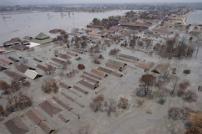 Since May 2006, a massive mudflow in Sidoarjo, East Java, Indonesia has left at least seven people dead, swallowed several villages, displaced 15,000 residents and destroyed 20 factories, all resulting in economic stagnation in the region. On Thursday, Indonesian police investigating the mudflow have pointed to poor management of oil drilling operations as the cause of one of the country’s worst industrial disasters. (See: Oil drilled blamed for fatal Java mudflow, Financial Times, March 8 2007.)
Since May 2006, a massive mudflow in Sidoarjo, East Java, Indonesia has left at least seven people dead, swallowed several villages, displaced 15,000 residents and destroyed 20 factories, all resulting in economic stagnation in the region. On Thursday, Indonesian police investigating the mudflow have pointed to poor management of oil drilling operations as the cause of one of the country’s worst industrial disasters. (See: Oil drilled blamed for fatal Java mudflow, Financial Times, March 8 2007.)
The ongoing investigation, with a view to possible criminal charges on the grounds of environmental damage, has looked at the activities of Lapindo Brantas Inc., which was conducting exploratory drillings when the mudflow began. In several statements and on its website, the firm has pledged to continue with cleanup efforts. (See: Three Months Later, Mudflows Still Plague Villages, Asia Water Wire, August 30, 2006.)
The cause of the mudflow, which has been gushing up to 200,000 cubic meters of boiling sludge daily since last May, was a point of discussion at an international geological workshop held in Jakarta in late February. While the workshop concluded that the mudflow is the result of a natural phenomenon – an eruption of a mud volcano at a depth of between 1-2 km below the surface of the earth – several others disagree. Richard Davies, a mud volcano specialist and professor at Durham University, disputes the conclusion of the conference. According to Indonesia Matters, an online Indonesian news source, Davies said drilling activities by Lapindo Brantas Inc. were the likeliest cause of the massive outpouring of mud. Furthermore, the head of the Geologists Alliance of Indonesia (IAGI) of 1973-1975, Koesoemadinata, has protested the result of the international workshop on the Lapindo mudflow. In an email, Koesoemadinata is reported to have said that the resolution of the workshop was erroneous and hastily concluded. (See: Sidoarjo Mudflow, Indonesia Matters, February 22, 2007.)
